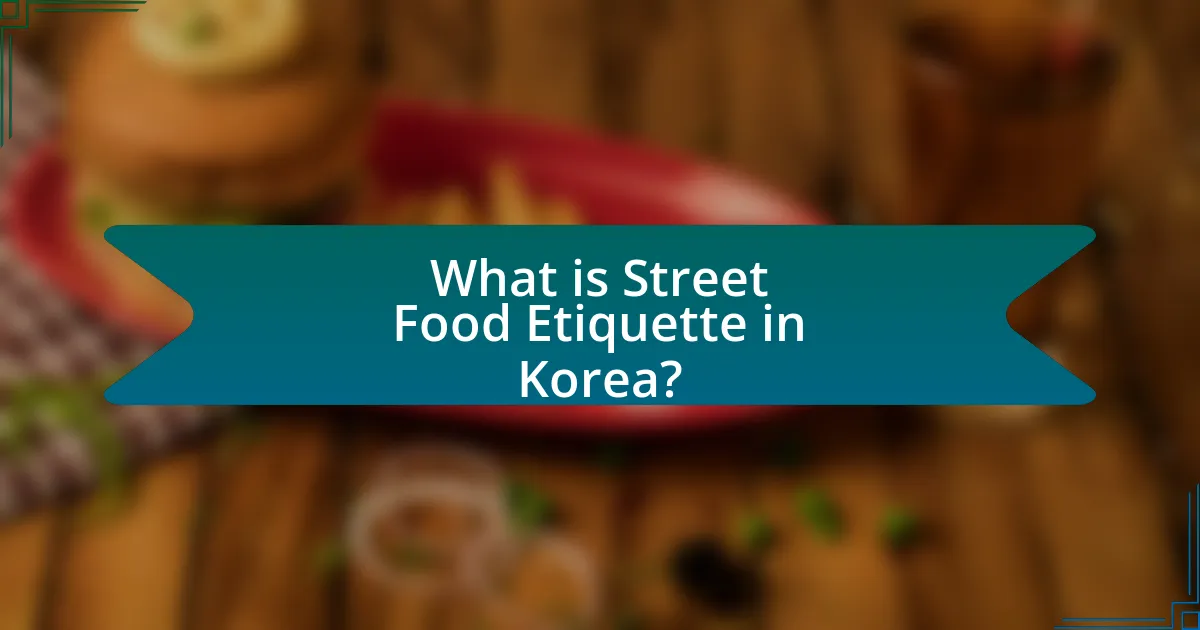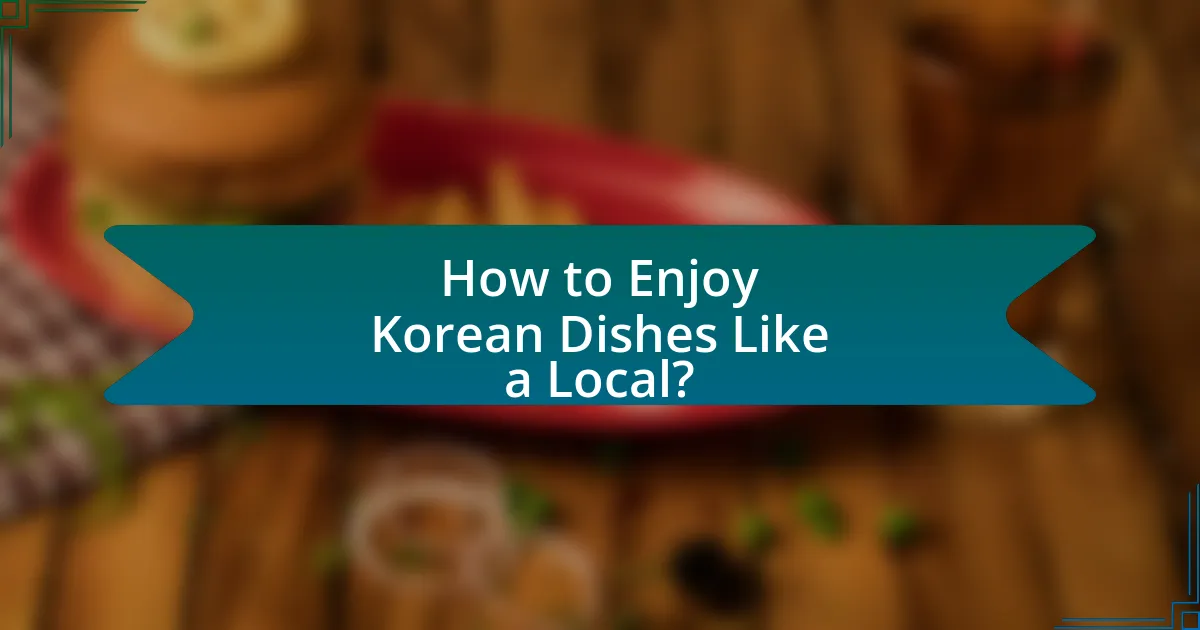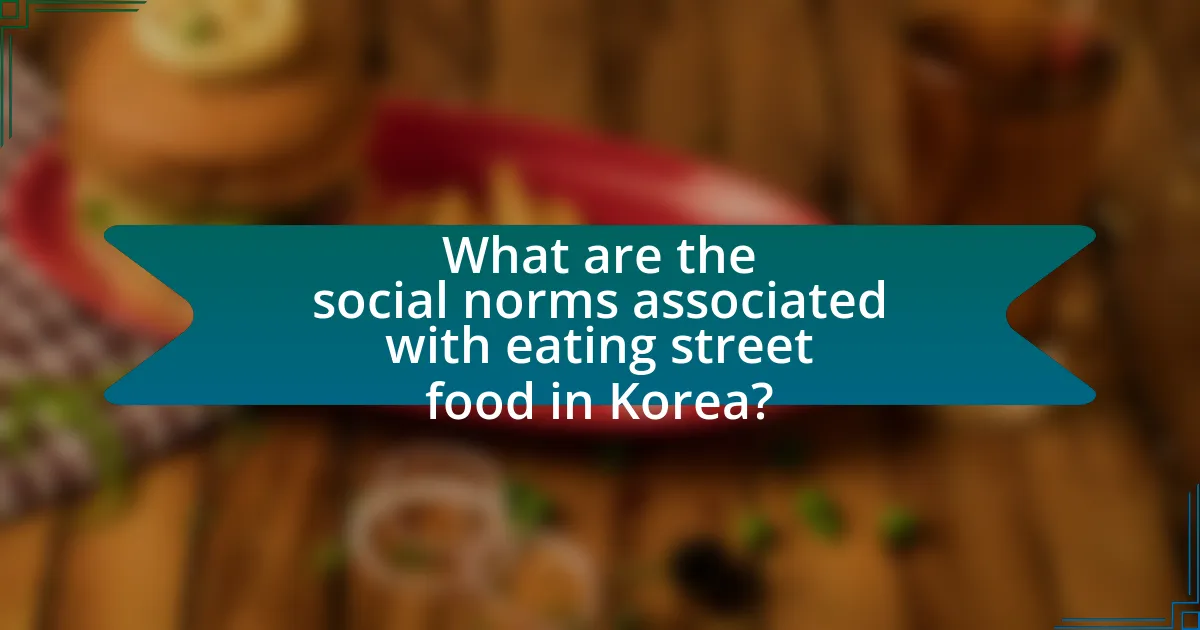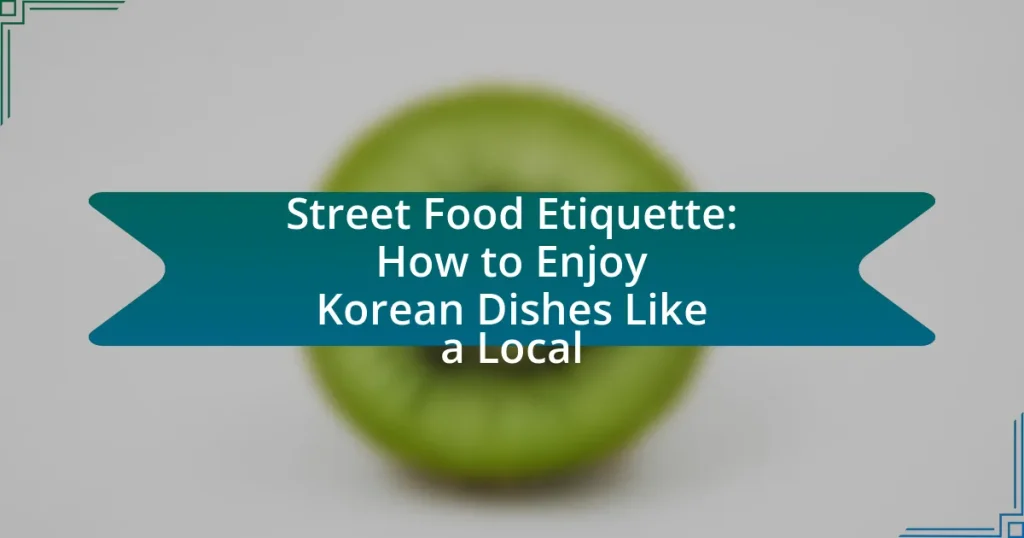The article focuses on street food etiquette in Korea, highlighting the importance of respect for vendors and cleanliness. It explores the cultural significance of street food as a communal experience that fosters social interactions and reflects regional diversity through unique dishes. Key principles of etiquette, such as polite greetings, proper ordering practices, and the significance of sharing food, are outlined. Additionally, the article provides practical tips for navigating the street food scene, including how to choose reputable vendors and avoid common pitfalls, ensuring a safe and enjoyable experience while savoring iconic Korean dishes.

What is Street Food Etiquette in Korea?
Street food etiquette in Korea emphasizes respect for vendors and cleanliness. When purchasing food, it is customary to greet the vendor politely and wait patiently for your order. Eating while standing is common, but it is important to avoid blocking foot traffic. Additionally, using utensils provided by the vendor, such as chopsticks or spoons, is expected, and disposing of trash properly in designated bins maintains cleanliness. This etiquette reflects the cultural values of respect and community in Korean society.
Why is street food important in Korean culture?
Street food is important in Korean culture because it serves as a vital expression of community and culinary tradition. It reflects the social fabric of urban life, where vendors offer affordable, diverse, and flavorful dishes that cater to the tastes of locals and tourists alike. Historically, street food has been a staple since the Joseon Dynasty, with dishes like tteokbokki and hotteok becoming iconic representations of Korean cuisine. This accessibility fosters social interaction, as people gather around food stalls, sharing experiences and building connections.
What role does street food play in social interactions?
Street food serves as a catalyst for social interactions by providing communal spaces where people gather to eat and socialize. In many cultures, including Korean, street food stalls create informal environments that encourage conversation and connection among diverse groups of individuals. For instance, in South Korea, popular street food markets like Myeongdong and Gwangjang Market attract locals and tourists alike, fostering a sense of community and shared experience. The act of sharing food, such as tteokbokki or hotteok, often leads to spontaneous interactions, enhancing social bonds and cultural exchange.
How does street food reflect regional diversity in Korea?
Street food in Korea reflects regional diversity through its unique ingredients, flavors, and cooking methods that vary by area. For instance, in Busan, the street food scene is characterized by seafood dishes like eomuk (fish cake) and ssiat hotteok (sweet pancakes with seeds), showcasing the coastal city’s access to fresh fish. In contrast, Seoul offers a variety of tteokbokki (spicy rice cakes) and gimbap (seaweed rice rolls), highlighting the capital’s urban culinary trends. Additionally, Jeonju is famous for its bibimbap, which emphasizes local vegetables and gochujang (red chili paste), representing the agricultural richness of the region. These regional specialties not only cater to local tastes but also reflect the cultural heritage and agricultural practices of each area, illustrating the diverse culinary landscape of Korea.
What are the basic principles of street food etiquette?
The basic principles of street food etiquette include being respectful to vendors, waiting your turn in line, and consuming food in designated areas. Respecting vendors fosters a positive interaction, as they often rely on customer goodwill for their business. Waiting in line demonstrates patience and consideration for others, which is crucial in busy street food environments. Consuming food in designated areas helps maintain cleanliness and order, which is important for both public health and the enjoyment of the dining experience.
How should one approach a street food vendor?
To approach a street food vendor, one should first observe the vendor’s setup and the menu offerings. This initial observation allows for understanding the available options and the vendor’s specialties. Next, approach the vendor with a friendly demeanor, making eye contact and greeting them politely, as this establishes a positive interaction. It is also advisable to ask questions about the food, such as ingredients or recommendations, which shows interest and respect for the vendor’s expertise. Engaging in this manner aligns with cultural norms in Korea, where politeness and respect are valued in social interactions.
What are the common practices for ordering food?
Common practices for ordering food in the context of Korean street food include approaching the vendor, clearly stating your order, and often paying upfront. Customers typically point to menu items or use simple phrases in Korean to communicate their choices, as many vendors may not speak English. Additionally, it is customary to wait patiently for your food, as preparation can take time, and to express gratitude with a polite “thank you” upon receiving your order. These practices enhance the experience and respect local customs, contributing to a more authentic dining experience.

How to Enjoy Korean Dishes Like a Local?
To enjoy Korean dishes like a local, immerse yourself in the street food culture by visiting popular markets such as Gwangjang Market or Myeongdong Street. Locals typically savor dishes like tteokbokki (spicy rice cakes) and hotteok (sweet pancakes) while standing at food stalls, emphasizing the communal and casual dining experience. Engaging with vendors, trying various dishes, and sharing food with friends enhances the experience, as sharing is a common practice in Korean dining culture. Additionally, using chopsticks and a spoon correctly, and being mindful of etiquette, such as not sticking chopsticks upright in rice, reflects respect for the food and tradition.
What are the must-try street food dishes in Korea?
The must-try street food dishes in Korea include tteokbokki, hotteok, and gimbap. Tteokbokki consists of chewy rice cakes in a spicy-sweet sauce, often served with fish cakes and boiled eggs, making it a popular choice among locals and tourists alike. Hotteok is a sweet pancake filled with brown sugar, cinnamon, and nuts, typically enjoyed during the colder months. Gimbap, often referred to as Korean sushi, features rice and various fillings rolled in seaweed, making it a convenient and flavorful snack. These dishes are widely available at street vendors across Korea, reflecting the country’s vibrant food culture.
What ingredients are commonly used in popular Korean street foods?
Common ingredients in popular Korean street foods include rice, flour, vegetables, meats, and various sauces. For instance, tteokbokki is made with rice cakes, fish cakes, and gochujang (red chili paste), while hotteok features a dough made from flour filled with brown sugar and nuts. Additionally, kimbap consists of rice, vegetables, and sometimes meat, all wrapped in seaweed. These ingredients reflect the diverse flavors and textures characteristic of Korean street cuisine.
How do the flavors of Korean street food differ from other cuisines?
Korean street food flavors are characterized by a unique balance of spicy, sweet, sour, and savory elements, setting them apart from other cuisines. This distinct flavor profile often includes ingredients like gochujang (red chili paste), which adds heat and depth, and doenjang (fermented soybean paste), contributing umami. Additionally, the use of fresh vegetables and herbs enhances the freshness and complexity of dishes. For example, tteokbokki, a popular street food, combines chewy rice cakes with a spicy-sweet sauce, showcasing the harmonious blend of flavors typical in Korean cuisine. This multifaceted approach to flavor contrasts with many Western street foods, which may focus more on single dominant flavors or simpler combinations.
How can one navigate the street food scene effectively?
To navigate the street food scene effectively, one should prioritize cleanliness, observe local eating customs, and choose busy vendors. Cleanliness is crucial; selecting stalls that maintain hygiene standards reduces the risk of foodborne illnesses. Observing local customs, such as how to order and eat specific dishes, enhances the experience and shows respect for the culture. Choosing busy vendors often indicates quality and popularity, as locals tend to frequent stalls with fresh and delicious offerings. These practices are supported by studies indicating that food safety and cultural awareness significantly enhance the street food experience.
What tips can help in choosing the best street food vendors?
To choose the best street food vendors, prioritize those with long lines, as high customer volume often indicates quality and popularity. Vendors who attract many customers typically offer fresh, flavorful dishes that locals trust. Additionally, observe the cleanliness of the vendor’s setup and food preparation area; a tidy environment suggests good hygiene practices. Look for vendors who prepare food in front of you, as this transparency can enhance trust in the food’s freshness and quality. Finally, seek recommendations from locals or online reviews, as these sources can provide insights into the best options available in the area.
How can one avoid common pitfalls when trying street food?
To avoid common pitfalls when trying street food, one should prioritize cleanliness and vendor reputation. Choosing stalls that are busy with locals often indicates quality and safety, as high turnover suggests fresh ingredients. Additionally, observing food preparation practices can reveal hygiene standards; for instance, vendors who wear gloves and maintain clean workspaces are more likely to serve safe food. According to a study published in the Journal of Food Protection, foodborne illnesses are significantly reduced when vendors adhere to proper sanitation protocols. Therefore, selecting reputable vendors and ensuring food is freshly prepared are key strategies for enjoying street food safely.

What are the social norms associated with eating street food in Korea?
Eating street food in Korea is often a communal and social experience, where sharing and enjoying food together is encouraged. It is common for individuals to eat while standing or walking, and vendors typically provide small portions that are easy to consume on the go. Additionally, it is customary to express appreciation to the vendor, often through a simple “thank you” in Korean, which fosters a friendly atmosphere. The practice of eating street food is also associated with trying a variety of dishes, as locals often sample multiple items from different stalls in one outing. This behavior reflects the cultural value placed on diversity in food experiences.
How should one behave while eating street food in public?
One should behave respectfully and considerately while eating street food in public. This includes being mindful of personal space, avoiding loud conversations, and not littering. Observing local customs, such as using chopsticks or hands appropriately, enhances the experience and shows respect for the culture. Additionally, waiting in line patiently and thanking the vendor after receiving food demonstrates good manners. Following these behaviors aligns with the social norms prevalent in street food culture, particularly in Korea, where communal dining and respect for food vendors are highly valued.
What are the expectations regarding sharing food with others?
Sharing food with others in the context of Korean street food etiquette is expected and often seen as a sign of hospitality and community. In Korean culture, sharing meals fosters social bonds and reflects a sense of togetherness, which is particularly important in communal dining settings. For instance, it is common for diners to order various dishes to share, allowing everyone to experience a range of flavors and textures. This practice is supported by the cultural norm that emphasizes collective enjoyment over individual consumption, reinforcing the idea that food is best appreciated in a communal atmosphere.
How does one show appreciation to the vendor?
One shows appreciation to the vendor by expressing gratitude verbally and providing positive feedback about the food. Verbal expressions such as “thank you” or compliments about the dish enhance the vendor’s experience and encourage them. Additionally, tipping, when culturally appropriate, can also signify appreciation for their service. In South Korea, while tipping is not customary, a sincere thank you can go a long way in showing respect and appreciation for the vendor’s hard work.
What are the cultural taboos to be aware of?
In Korean culture, several cultural taboos are important to observe, particularly when enjoying street food. One significant taboo is the act of sticking chopsticks upright in a bowl of rice, as this resembles a funeral ritual and is considered disrespectful. Additionally, it is frowned upon to point with chopsticks or to pass food directly from one set of chopsticks to another, as this also mimics funeral practices. Furthermore, eating while walking is generally discouraged; locals prefer to eat at designated areas to show respect for the food and the vendors. Understanding these taboos enhances the experience of enjoying Korean street food and demonstrates cultural sensitivity.
What actions are considered disrespectful in the street food context?
Disrespectful actions in the street food context include littering, cutting in line, and being rude to vendors. Littering shows a lack of respect for the environment and the community, while cutting in line disregards the patience of others waiting for food. Additionally, being rude to vendors undermines their hard work and can create a negative atmosphere. These behaviors are widely recognized as disrespectful in various cultures, including Korean street food culture, where communal respect and politeness are highly valued.
How can one avoid offending locals while enjoying street food?
To avoid offending locals while enjoying street food, one should respect local customs and practices. This includes observing dining etiquette, such as using chopsticks correctly, not sticking them upright in rice, and waiting for locals to start eating before beginning. Additionally, learning a few basic phrases in Korean can demonstrate respect and appreciation for the culture. Engaging with vendors politely and showing interest in their food can also foster positive interactions. According to cultural studies, understanding and adhering to local norms significantly enhances the dining experience and minimizes the risk of offending locals.
What practical tips can enhance the street food experience?
To enhance the street food experience, prioritize cleanliness by choosing vendors with high turnover and visible hygiene practices. Observing the crowd can indicate the quality of food; popular stalls often serve fresher dishes. Additionally, engage with local vendors to gain insights about the food, as they can provide recommendations and context about the dishes. Sampling a variety of items allows for a broader experience of flavors and textures, which is essential in street food culture. Lastly, being open to trying new foods can lead to discovering unique local specialties that may not be widely known.
How can one stay safe while enjoying street food?
To stay safe while enjoying street food, one should choose vendors that maintain high hygiene standards, such as those with clean cooking areas and visible food preparation. Research indicates that foodborne illnesses are often linked to improper food handling; therefore, selecting stalls that are busy can be a good indicator of freshness and safety, as high customer turnover typically reflects quality. Additionally, consuming food that is cooked thoroughly and served hot minimizes the risk of contamination, as pathogens are less likely to survive at high temperatures.
What are the best times to explore street food markets?
The best times to explore street food markets are typically during the late afternoon to evening, specifically from around 5 PM to 10 PM. This timeframe coincides with peak dining hours when vendors are fully stocked and the atmosphere is vibrant, attracting both locals and tourists. Additionally, many street food markets in Korea come alive during weekends and holidays, offering a wider variety of food options and a lively social environment.


